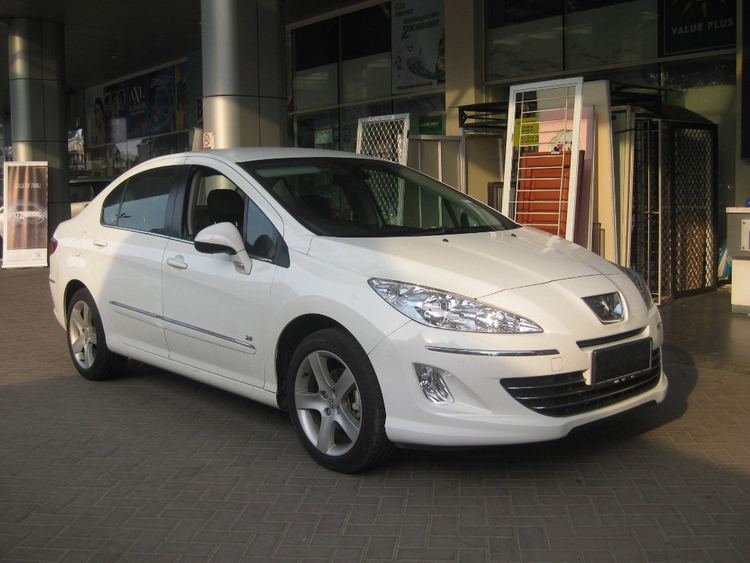Manufacturer Peugeot Class Small family car (C) Layout FF layout | Production 2010–present Body style 4-door saloon | |
 | ||
Assembly Argentina: El Palomar (PSA Argentina)
China: Wuhan (DPCA)
Malaysia: Gurun (NAM)
Russia: Kaluga | ||
The Peugeot 408 is a small family car produced by Peugeot. It was unveiled on January 25, 2010, at the Beijing Auto Show and sales began in China on April 8, 2010. In November 2010, production of the 408 commenced in El Palomar, Buenos Aires, Argentina, with sales starting in April 2011.
Contents
- First generation 2010 2014
- Second generation 2014 current
- Features
- Performance and Environmental
- References
Despite its name, it is not the successor to the Peugeot 407, but rather a long-wheelbase saloon version of the Peugeot 308 hatchback, primarily targeted at emerging markets such as China.
The 408 is not slated for the Western European market, and not built there. Depending on where this car is produced, there are both internal and external differences. The front of the car is one of the visible changes, but also the low rear end is different. Indeed, in some markets, there are cars with the front of the South American version and the back of the Chinese version. Inside the vehicle, the most noticeable difference is seen at the door.
First generation (2010-2014)
The 408 is available in China with either a 1.6 L and 2.0 L petrol four-cylinder engine. The 1.6 (TU5JP4) has a capacity of 1587 cc and produces 110 bhp (82 kW; 112 PS) at 5,750 r.p.m. and maximum torque of 147 N·m (108 lb·ft) at 4,000 rpm. The 2.0 L(EW10A+) engine has a capacity of 1997 cc and produces 147 bhp (110 kW; 149 PS) at 6,000 rpm and 200 N·m (148 lb·ft) at 4,000 rpm. Either engine can be specified with a five-speed manual or four-speed automatic transmission.
In South America a 1.6 L diesel engine, known as a HDi (Allure,Feline/Griffe), is sold alongside the 2.0 L petrol engine (Allure, Feline/Griffe) and 1.6L THP petrol engine (Sport) with six-speed automatic transmission. The four-cylinder diesel has a capacity of 1560 cc and produces 143 bhp (107 kW; 145 PS) and torque of 240 N·m (177 lb·ft). The HDi has a top speed of 188 km/h (116.8 mph) and accelerates to 100 km/h (62 mph) in 12.4 seconds.
In Malaysia, 408 comes with two engines, 1.6L Prince turbo engine and 2.0L petrol four-cylinder engine. The 1.6L engine produces 163 bhp (122 kW; 165 PS) at 6,000 rpm. and maximum torque of 240 N·m (177 lb·ft) from 1,400 rpm. The 2.0 L(EW10A+) engine has a capacity of 1997 cc and produces 145 bhp (108 kW; 147 PS) at 6,000 rpm and 200 N·m (148 lb·ft) at 4,000 rpm. 1.6L Prince turbo engines mated with 6-speed and 2.0L engine mated with 4 speeds auto adaptive gearbox with Tiptronic and Sport mode only.
The 408 First Generation continues in production in Latin America, with a front/rear facelift and minor changes. Front was restyled with grille and headlamps in 408 Second Generation style.
Second generation (2014-current)
The second generation Peugeot 408 was unveiled in the 2014 Beijing Auto Show.
In June, 2016. Peugeot 408 International Version (As known as Peugeot 408 e-THP) was launched first at NAZA Tower in Malaysia with only one engine choice and transmission.
Features
The main features include: Peugeot i-Cockpit interior, Full LED headlight (carry from base vehicle, 308), Smart Park Assist II, Blind Spot Information System, Auto Electric Parking Brake, Engine Start-Stop System, and Electric Seat + Massage (Driver), and Electric Seat. (Front Passenger)
Performance and Environmental
Dynamic Performance performance: 0-100 kph: 8.2 s
* Test with New European Driving Cycle (NEDC)
